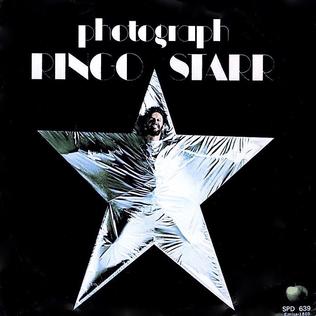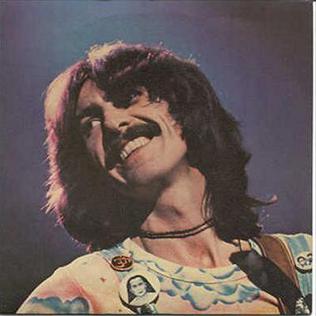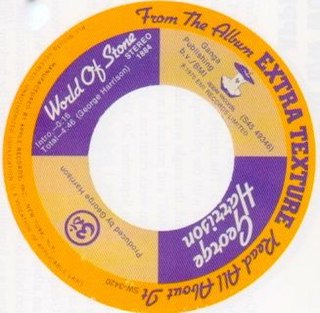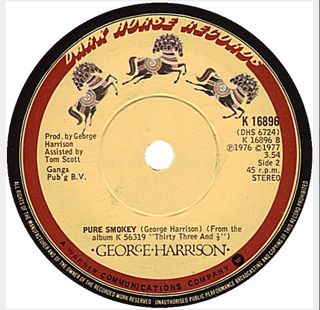Related Research Articles

Extra Texture is the sixth studio album by English musician George Harrison, released on 22 September 1975. It was Harrison's final album under his contract with Apple Records and EMI, and the last studio album issued by Apple. The release came nine months after his troubled 1974 North American tour with Ravi Shankar and the poorly received Dark Horse album.

Dark Horse is the fifth studio album by English rock musician George Harrison. It was released on Apple Records in December 1974 as the follow-up to Living in the Material World. Although keenly anticipated on release, Dark Horse is associated with the controversial North American tour that Harrison staged with Indian classical musician Ravi Shankar in November and December that year. This was the first US tour by a member of the Beatles since 1966, and the public's nostalgia for the band, together with Harrison contracting laryngitis during rehearsals and choosing to feature Shankar so heavily in the programme, resulted in scathing concert reviews from some influential music critics.

"Photograph" is a song by English rock musician Ringo Starr that was released as the lead single from his 1973 album Ringo. Starr co-wrote it with George Harrison, his former bandmate from the Beatles. Although they collaborated on other songs, it is the only one officially credited to the pair. A signature tune for Starr as a solo artist, "Photograph" was an international hit, topping singles charts in the United States, Canada and Australia, and receiving gold disc certification for US sales of 1 million. Music critics have similarly received the song favourably; Stephen Thomas Erlewine of AllMusic considers it to be "among the very best post-Beatles songs by any of the Fab Four".

"Ding Dong, Ding Dong" is a song by English rock musician George Harrison, written as a New Year's Eve singalong and released in December 1974 on his album Dark Horse. It was the album's lead single in Britain and some other European countries, and the second single, after "Dark Horse", in North America. A large-scale production, the song incorporates aspects of Phil Spector's Wall of Sound technique, particularly his Christmas recordings from 1963. In addition, some Harrison biographers view "Ding Dong" as an attempt to emulate the success of two glam rock anthems from the 1973–74 holiday season: "Merry Xmas Everybody" by Slade, and Wizzard's "I Wish It Could Be Christmas Everyday". The song became only a minor hit in Britain and the United States, although it was a top-twenty hit elsewhere in the world.

"You" is a song by English musician George Harrison, released as the opening track of his 1975 album Extra Texture . It was also the album's lead single, becoming a top 20 hit in America and reaching number 9 in Canada. A 45-second instrumental portion of the song, titled "A Bit More of You", appears on Extra Texture also, opening side two of the original LP format. Harrison wrote "You" in 1970 as a song for Ronnie Spector, formerly of the Ronettes, and wife of Harrison's All Things Must Pass co-producer Phil Spector. The composition reflects Harrison's admiration for 1960s American soul/R&B, particularly Motown.

"This Guitar " is a song by English rock musician George Harrison, released on his 1975 studio album Extra Texture . Harrison wrote the song as a sequel to his popular Beatles composition "While My Guitar Gently Weeps", in response to the personal criticism he had received during and after his 1974 North American tour with Ravi Shankar, particularly from Rolling Stone magazine. An edit of "This Guitar" was issued as a single in December 1975, as the final release by Apple Records in its original incarnation. The single failed to chart in either the United States or Britain.
"Far East Man" is a song written by English rock musicians George Harrison and Ronnie Wood, each of whom released a recording of the song in 1974. Wood's version appeared on I've Got My Own Album to Do, his debut solo album, and Harrison's on Dark Horse. Their only official songwriting collaboration, "Far East Man" is an affirmation of friendship in the face of life's obstacles and musically reflects the two guitarists' adoption of the soul genre. Written mostly by Harrison, the composition has been interpreted as a restatement of the humanitarian message expressed in his 1971 single "Bangla Desh", and a tribute to Indian musician Ravi Shankar.
"Don't Let Me Wait Too Long" is a song by English rock musician George Harrison, released on his 1973 album Living in the Material World. It was scheduled to be issued as a single in September that year, as the follow-up to "Give Me Love ", but the release was cancelled. Music critics have traditionally viewed "Don't Let Me Wait Too Long" as a highlight of the Material World album, praising its pop qualities and production, with some considering the song worthy of hit status.
"Sue Me, Sue You Blues" is a song written by English musician George Harrison, released on his 1973 album Living in the Material World. Harrison initially let American guitarist Jesse Ed Davis record it for the latter's Ululu album (1972), in gratitude to Davis for his participation in the Concert for Bangladesh. When writing the song, Harrison drew inspiration from the legal issues surrounding the Beatles during the early months of 1971, particularly the lawsuit that Paul McCartney initiated in an effort to dissolve the band's business partnership, Apple Corps.
"Who Can See It" is a song by English musician George Harrison, released on his 1973 album Living in the Material World. The lyrics reflect Harrison's uneasy feelings towards the Beatles' legacy, three years after the group's break-up, and serve as his statement of independence from expectations raised by the band's unprecedented popularity. Some music critics and biographers suggest that he wrote the song during a period of personal anguish, following the acclaim he had received as a solo artist with the 1970 triple album All Things Must Pass and his 1971–72 Bangladesh aid project. The revelatory nature of the lyrics has encouraged comparisons between Living in the Material World and John Lennon's primal therapy-inspired 1970 release, Plastic Ono Band.

"World of Stone" is a song by English rock musician George Harrison, released in 1975 on Extra Texture , his final album for Apple Records. It was also issued as the B-side of the album's lead single, "You". Harrison wrote the song in 1973 but recorded it two years later, following the unfavourable critical reception afforded his 1974 North American tour with Ravi Shankar and the Dark Horse album. Due to its context on release, commentators view "World of Stone" as a plea from Harrison for tolerance from these detractors. According to some of his biographers, the lyrics reflect Harrison's doubts regarding his devotion to a spiritual path – an apparent crisis of faith that followed his often-unwelcome spiritual pronouncements during the tour, and which permeated his work throughout 1975.

"Hari's on Tour (Express)" is an instrumental by English musician George Harrison, released as the opening track of his 1974 album Dark Horse. It was also the B-side of the album's second single – which was "Ding Dong, Ding Dong" in North America and most other territories, and "Dark Horse" in Britain and some European countries. Among Harrison's post-Beatles solo releases, the track is the first of only two genuine instrumentals he released from 1970 onwards – the other being the Grammy Award-winning "Marwa Blues", from his 2002 album Brainwashed.

"Māya Love" is a song by English musician George Harrison, released on his 1974 album Dark Horse. The song originated as a slide guitar tune, to which Harrison later added lyrics relating to the illusory nature of love – maya being a Sanskrit term for "illusion", or "that which is not". Harrison's biographers consider the lyrical theme to be reflective of his failed marriage to Pattie Boyd, who left him for his friend Eric Clapton shortly before the words were written. Harrison recorded the song at his home, Friar Park, on the eve of his North American tour with Ravi Shankar, which took place in November and December 1974. The recording features Harrison's slide guitar extensively and contributions from four musicians who formed the nucleus of his tour band: Billy Preston, Tom Scott, Willie Weeks and Andy Newmark. Reviewers note the track as an example of its parent album's more diverse musical genres, namely funk and rhythm and blues, compared with the more traditional rock orientation of Harrison's earlier solo work.
"The Answer's at the End" is a song by English rock musician George Harrison, released in 1975 on his final album for Apple Records, Extra Texture . Part of the song lyrics came from a wall inscription at Harrison's nineteenth-century home, Friar Park, a legacy of the property's original owner, Sir Frank Crisp. This aphorism, beginning "Scan not a friend with a microscopic glass", had resonated with Harrison since he bought Friar Park in 1970, and it was a quote he often used when discussing his difficult relationship with his former Beatles bandmate Paul McCartney.
"Ooh Baby " is a song by English musician George Harrison, released in 1975 on his album Extra Texture . Harrison wrote the composition as a tribute to American singer Smokey Robinson, whom he often identified as one of his favourite vocalists and songwriters. The song was intended as a companion piece to Robinson's 1965 hit with the Miracles, "Ooo Baby Baby", and its inclusion on Extra Texture contributed to that album's standing as Harrison's soul music album. His impersonation of Robinson's celebrated vocal style on the track, including portions sung in falsetto, contrasted with Harrison's hoarse, laryngitis-marred singing on his 1974 North American tour and the poorly received Dark Horse album.
"Grey Cloudy Lies" is a song by English rock musician George Harrison from his 1975 album Extra Texture . Harrison wrote it in 1973 during a period that he characterised as his "naughty" years, coinciding with the failure of his marriage to Pattie Boyd and his divergence from the ascetic path of his Hindu-aligned faith. He returned to the song two years later when filled with despondency and self-doubt in response to the scathing reviews that his 1974 North American tour with Ravi Shankar and Dark Horse album had received from several music critics.
"His Name Is Legs " is a song by English rock musician George Harrison, released in 1975 as the closing track of his album Extra Texture . The song is a tribute to "Legs" Larry Smith, the drummer with the 1960s satirical-comedy group the Bonzo Dog Doo-Dah Band and one of many comedians with whom Harrison began associating during the 1970s. Smith appears on the recording, delivering a spoken monologue, while Harrison's lyrics similarly reflect the comedian's penchant for zany wordplay. The song serves as a precursor to Harrison's work with Monty Python members Eric Idle and Michael Palin, including his production of the troupe's 1975 single "The Lumberjack Song" and films such as Life of Brian (1979) that he produced under the aegis of his company HandMade Films.
"Beautiful Girl" is a song by English musician George Harrison, released on his 1976 album Thirty Three & 1/3. Harrison began writing the song in 1969 and considered recording it for his 1970 triple album All Things Must Pass. In its finished, 1976 form, the lyrics of "Beautiful Girl" were inspired by Harrison's second wife, Olivia Arias.

"Pure Smokey" is a song by English musician George Harrison, released in 1976 on his debut album for Dark Horse Records, Thirty Three & 1/3. The song was the second of Harrison's musical tributes to American soul singer Smokey Robinson, following "Ooh Baby " in 1975. Harrison frequently cited Robinson as one of his favourite vocalists and songwriters, and Robinson's group the Miracles had similarly influenced the Beatles during the 1960s. In the lyrics to "Pure Smokey", Harrison gives thanks for the gift of Robinson's music, while making a statement regarding the importance of expressing appreciation and gratitude, rather than forgetting to do so and later regretting it. The song title came from the name of Robinson's 1974 album Pure Smokey.
"So Sad" is a song by English rock musician George Harrison that was released on his 1974 album Dark Horse. Harrison originally recorded the song for his previous album, Living in the Material World, before giving it to Alvin Lee, the guitarist and singer with Ten Years After. Lee recorded it – as "So Sad " – with gospel singer Mylon LeFevre for their 1973 album On the Road to Freedom. The latter recording includes contributions from Harrison and marked the first of several collaborations between him and Lee.
References
- 1 2 3 4 5 Leng, p. 184.
- ↑ Harrison, pp. 383–86.
- 1 2 3 4 5 6 Madinger & Easter, p. 452.
- 1 2 3 4 George Harrison interview, Rockweek, "George Harrison explains 'A Bit More of You' and 'Can't Stop Thinking About You'" on YouTube (retrieved 5 June 2014).
- 1 2 Leng, p. 165.
- ↑ Tillery, pp. 94, 116.
- ↑ Boyd, p. 175.
- ↑ O'Dell, pp. 256–58.
- ↑ O'Dell, pp. 262–63.
- ↑ Tillery, pp. 93–94.
- ↑ Boyd, p. 177.
- ↑ Mick Brown, "An Interview with George Harrison", Rolling Stone , 19 April 1979; available at Rock's Backpages (subscription required).
- ↑ Harrison, pp. 274, 282.
- ↑ Allison, p. 7.
- ↑ Tillery, p. 116.
- ↑ Allison, pp. 12, 127, 138.
- 1 2 3 4 Inglis, p. 53.
- 1 2 Song lyrics, booklet with Extra Texture (Read All About It) CD (Apple Records, 2014; produced by George Harrison), p. 14.
- 1 2 Clayson, p. 349.
- 1 2 Leng, pp. 184, 186.
- ↑ The Editors of Rolling Stone, p. 192.
- ↑ Clayson, p. 283.
- 1 2 Rodriguez, p. 184.
- ↑ Badman, pp. 164, 165.
- ↑ Schaffner, p. 176.
- ↑ Woffinden, pp. 83–84.
- 1 2 3 4 Huntley, p. 126.
- ↑ Tillery, p. 94.
- ↑ Greene, pp. 220–21.
- ↑ Harrison, p. 1.
- ↑ Rodriguez, p. 424.
- ↑ Harrison, pp. 190, 366.
- ↑ "Announcing The Apple Years 1968–75 Box set – Released 22nd September", georgeharrison.com, 2 September 2014 (retrieved 10 October 2014).
- ↑ Essay by Kevin Howlett, booklet with Extra Texture (Read All About It) CD (Apple Records, 2014; produced by George Harrison), p. 9.
- ↑ Rodriguez, pp. 59, 384.
- ↑ Woffinden, p. 86.
- ↑ The Editors of Rolling Stone, p. 44.
- ↑ Rodriguez, pp. 159, 263.
- ↑ Leng, pp. 141–42.
- ↑ Spizer, pp. 293, 297, 303, 338.
- ↑ Leng, p. 186.
- ↑ Spizer, p. 342.
- ↑ Clayson, p. 358.
- 1 2 Ingham, p. 134.
- ↑ Woffinden, pp. 85–86.
- ↑ Clayson, p. 348.
- ↑ Rodriguez, pp. 247–48, 280.
- ↑ Madinger & Easter, p. 451.
- ↑ Leng, pp. 178−79.
- ↑ Leng, pp. 178, 187.
- ↑ Huntley, pp. 122–23.
- 1 2 3 4 Spizer, p. 274.
- ↑ Clayson, pp. 250–51.
- ↑ Woffinden, pp. 84, 86.
- ↑ Leng, pp. 160, 174–75.
- ↑ Huntley, pp. 112–13.
- ↑ Jim Miller, "Dark Horse: Transcendental Mediocrity", Rolling Stone , 13 February 1975, pp. 75–76.
- ↑ Castleman & Podrazik, p. 375.
- ↑ Leng, p. 180.
- ↑ Clayson, pp. 348–49.
- ↑ Rodriguez, p. 385.
- ↑ Badman, p. 169.
- ↑ Schaffner, pp. 182, 212.
- ↑ Castleman & Podrazik, p. 369.
- ↑ Leng, pp. 180, 184.
- 1 2 Allison, p. 138.
- ↑ Inglis, p. 51.
- ↑ Lindsay Planer, "George Harrison 'This Guitar (Can't Keep from Crying)'", AllMusic (retrieved 10 October 2014).
- ↑ Spizer, p. 277.
- ↑ Dave Marsh, "George Harrison Extra Texture" Archived 20 September 2017 at the Wayback Machine , Rolling Stone , 20 November 1975, p. 75 (retrieved 22 April 2013).
- ↑ Ray Coleman, "Extra Texture: Back to the Sixties!", Melody Maker , 6 September 1975, p. 30.
- ↑ Paul Du Noyer, "Back Catalogue: George Harrison", Blender , April 2004, pp. 152–53.
- ↑ Huntley, pp. 125–26.
- ↑ Joe Marchese, "Review: The George Harrison Remasters – 'The Apple Years 1968–1975'", The Second Disc, 23 September 2014 (retrieved 10 October 2014).
- ↑ Tom Doyle, "Hari Styles: George Harrison The Apple Years 1968–1975", Mojo , November 2014, p. 109.